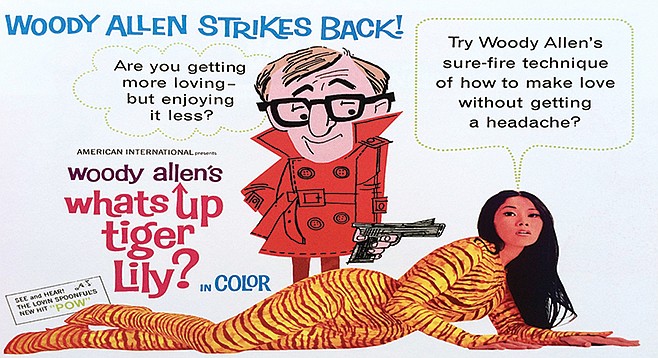 Facebook
Facebook
 X
X
 Instagram
Instagram
 TikTok
TikTok
 Youtube
Youtube

Celebrate Woody Allen’s 83rd birthday with a trio of early, funny movies
What’s Up, Tiger Lily? (1966)
My first Woody. At fourteen, a sickbed viewing induced enough laughter to swat the flu bug right out of me. American International Pictures president Henry G. Saperstein owned the rights to the Japanese action flick Key of Keys. He came up with the concept of redubbing the otherwise unfathomable foreign fare and turning it into a comedy. Allen, making his directorial debut of sorts, devised the spy spoof angle, in which rival agents vie for an egg salad recipe that’s to die for. The voiceovers by Allen & Co. — the second Mrs. Allen, Louise Lasser, Mickey Rose, Len Maxwell with the weather, etc. — bring to mind the slapdash fervor of a Looney Tune. In need of padding for the scant running time, Allen filmed four additional sequences. Not satisfied, the studio brought in The Lovin’ Spoonful to add a few musical numbers. Allen threatened to sue just long enough to learn that the picture was turning a profit.
Take the Money and Run (1968)
The month after Tiger Lily worked its healing magic on me saw a revival of this early effort. It was my first theatrical Woody, and ever since, I’ve seen all of his films — in a theater — on or before opening day. Woody’s expose of the life of bumbling criminal Virgil Starkwell has been called the first mockumentary. Jerry Lewis declined Allen’s offer to direct, citing prior commitments. A shoddily assembled joke machine, one can only imagine how much better it would have been with Lewis at the helm. Legend has it that the film’s true auteur was editor Ralph Rosenbloom, who restructured the film and also convinced the fledgling director to record scene-bridging voiceovers and excise the bloodbath that originally closed the picture. This is a film to be judged, not on its formal finesse, but on the number of laughs produced during its mixmaster approach to storytelling. On that level, it’s a pretty damn funny success.
Play it Again, Sam (1972)
Woody stars as a neurotic film critic whose obsession with Casablanca has him regularly conversing with the ghost of Humphrey Bogart. Conceived for the stage, Woody dedicated a year of his life to performing the play on Broadway. When it came time for the big-screen bump-up, he adapted the play, but, not wanting to simply re-trace his most recent success, handed the director’s reins to Herbert Ross. According to Cinema Magazine, Woody aimed for “a nice, solid, funny commercial picture [that would] hopefully entice a broader audience for me than I get with my own films.” He got what he asked for in terms of both box office success and artistic control. His first of eight collaborations with Diane Keaton — and his one and only picture for Paramount — Sam established Woody’s reputation as both movie star and sex symbol.


Celebrate Woody Allen’s 83rd birthday with a trio of early, funny movies
What’s Up, Tiger Lily? (1966)
My first Woody. At fourteen, a sickbed viewing induced enough laughter to swat the flu bug right out of me. American International Pictures president Henry G. Saperstein owned the rights to the Japanese action flick Key of Keys. He came up with the concept of redubbing the otherwise unfathomable foreign fare and turning it into a comedy. Allen, making his directorial debut of sorts, devised the spy spoof angle, in which rival agents vie for an egg salad recipe that’s to die for. The voiceovers by Allen & Co. — the second Mrs. Allen, Louise Lasser, Mickey Rose, Len Maxwell with the weather, etc. — bring to mind the slapdash fervor of a Looney Tune. In need of padding for the scant running time, Allen filmed four additional sequences. Not satisfied, the studio brought in The Lovin’ Spoonful to add a few musical numbers. Allen threatened to sue just long enough to learn that the picture was turning a profit.
Take the Money and Run (1968)
The month after Tiger Lily worked its healing magic on me saw a revival of this early effort. It was my first theatrical Woody, and ever since, I’ve seen all of his films — in a theater — on or before opening day. Woody’s expose of the life of bumbling criminal Virgil Starkwell has been called the first mockumentary. Jerry Lewis declined Allen’s offer to direct, citing prior commitments. A shoddily assembled joke machine, one can only imagine how much better it would have been with Lewis at the helm. Legend has it that the film’s true auteur was editor Ralph Rosenbloom, who restructured the film and also convinced the fledgling director to record scene-bridging voiceovers and excise the bloodbath that originally closed the picture. This is a film to be judged, not on its formal finesse, but on the number of laughs produced during its mixmaster approach to storytelling. On that level, it’s a pretty damn funny success.
Play it Again, Sam (1972)
Woody stars as a neurotic film critic whose obsession with Casablanca has him regularly conversing with the ghost of Humphrey Bogart. Conceived for the stage, Woody dedicated a year of his life to performing the play on Broadway. When it came time for the big-screen bump-up, he adapted the play, but, not wanting to simply re-trace his most recent success, handed the director’s reins to Herbert Ross. According to Cinema Magazine, Woody aimed for “a nice, solid, funny commercial picture [that would] hopefully entice a broader audience for me than I get with my own films.” He got what he asked for in terms of both box office success and artistic control. His first of eight collaborations with Diane Keaton — and his one and only picture for Paramount — Sam established Woody’s reputation as both movie star and sex symbol.
Comments